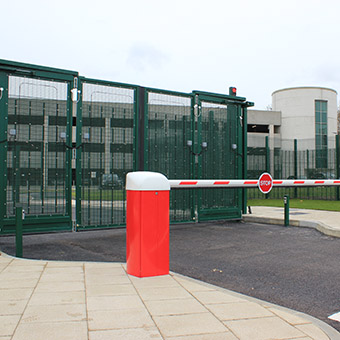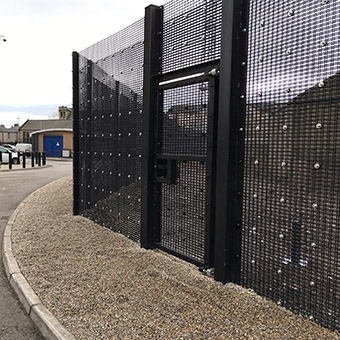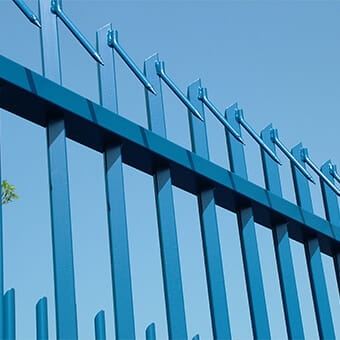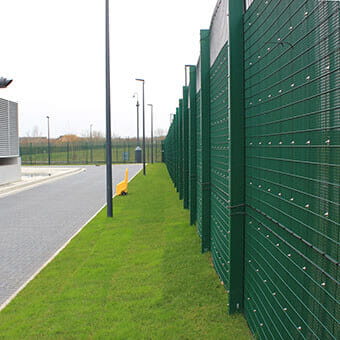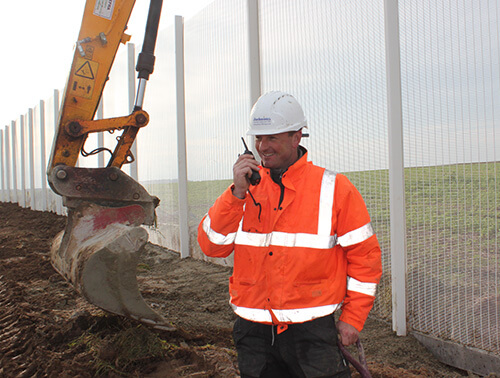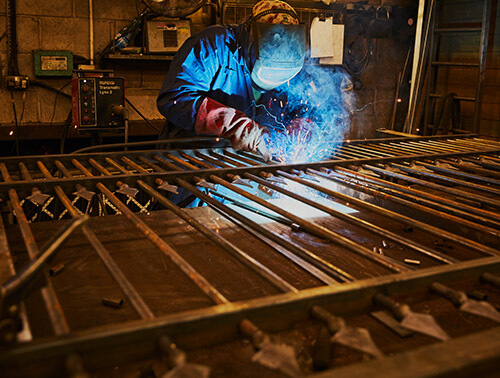Our other sites:
- Prison Fencing Overview
- Prison Fencing Design
- Gates and Access Control
- Internal Fencing and Compounds
- Acoustic Barriers for Prisons
In England and Wales, there are a number of different types of prison including male, women, and Young Offender Institutes. Male prisoners are categorised based on their risk of escape, their level of harm to the public if they were to escape, and their threat to the control and stability of a prison. Categories range from D (lowest security open prisons) to A (the highest). Female prisoners are classified into two groups: Restricted Status, equivalent to Category A for male prisoners, or uncategorised. Those without a specific category may be placed in either closed or open conditions, determined by their behaviour and risk of escape while youth prison concentrate more on rehabilitation to help integrate inmates back into society.
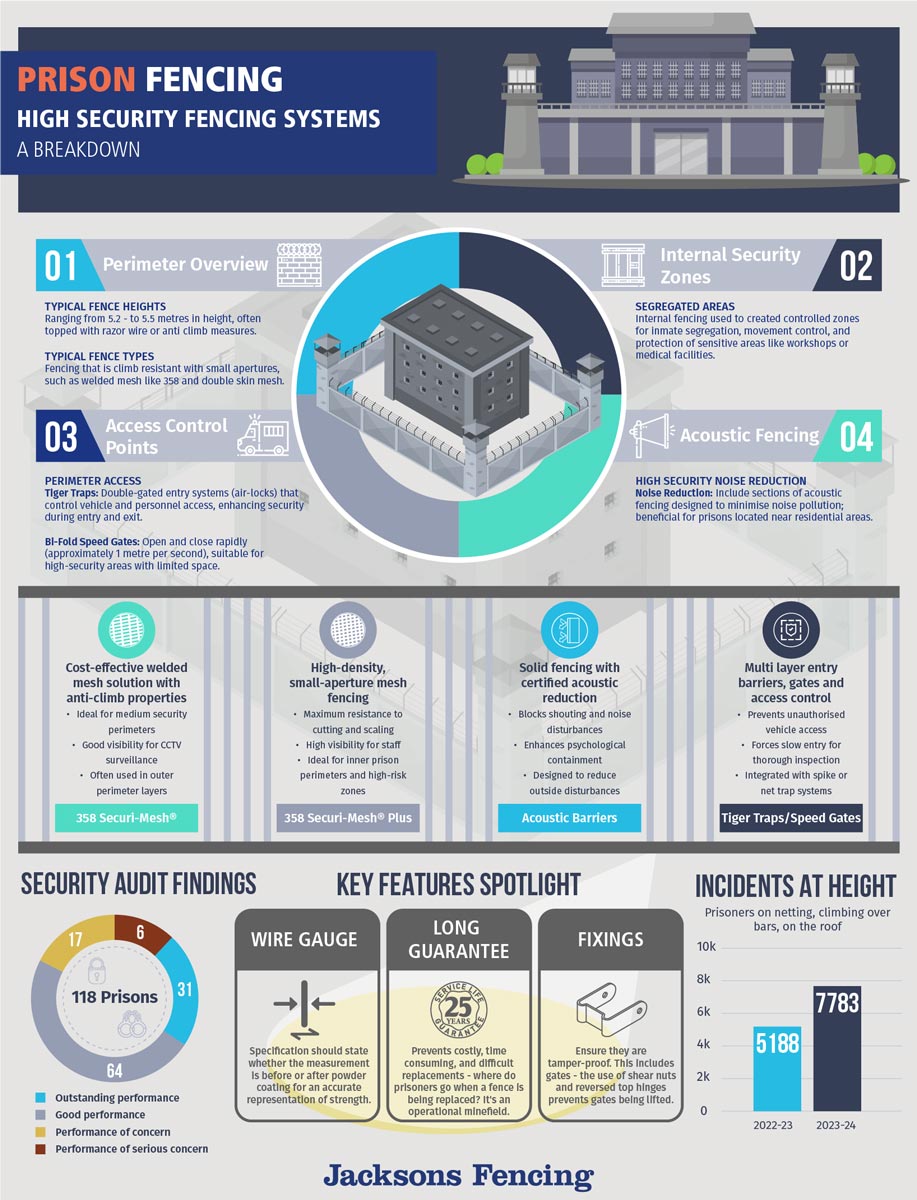
Prisons in all categories need security fencing and gates to prevent escapes and protect the public, control movement within the facility, enhance security against external threats, reduce privacy issues, and stop smuggling. Security fencing provides a robust physical barrier that, when combined with surveillance, access control systems, and internal security measures, helps create a safe and orderly environment for inmates, staff, and the public.
In July 2024, the prisoner population of England and Wales stood at 87,479, while maximum capacity of all prisons was 88,862. A plan to create an extra 20,000 prison places was already well underway to be built by the mid-2020s, but in the meantime, an early release scheme in Autumn 2024 saw the prison population drop by about 2.5%. With a former inmate reoffending on the same day, it is clear that new prison spaces are extremely necessary.
An inspection at HMP Brixton; one of the UK’s most overcrowded prisons, found “‘appalling’ conditions and failures to take basic steps to reduce inmates’ potential risk to the public’. In addition, 42% of inmates stated it was easy to procure illicit drugs.
Most worryingly for the public perhaps is the threat of prison escapes, with 2024 figures showing that 9 escapes happened between April 2023 and March 2024, but more concerningly, 23 of the 118 prisons in a security audit have a ‘performance of concern’ rating, including 6 rated ‘serious’. Additionally, ‘incidents at height’, including prisoners on the netting, climbing over bars, or on the roof increased from 5188 incidents in 2022-23, to 7783 in 2023-24. As part of the ‘support for prison build applications’ a new permitted development right was introduced in July 2023, to allow for prison fence heights up to 5.5 metres. New prisons, such as HMP Millsike, will take advantage of this.
Adequately securing the perimeter of our prisons is key, and high security perimeter solutions, such as fences and gates, must provide enhanced protection in order to combat the reported issues and give security personnel the time to mount an appropriate response. However, even with the height increase, it is not enough to simply install a 5.5m high fence and hope for the best. As well as combatting the current crisis, prisons need to be future-proofed too.

Prison security fencing plays a vital role in ensuring the safety, security, and containment of inmates within correctional facilities. In the UK, the design and structure of prison fences are carefully regulated to meet strict security requirements, while also balancing operational efficiency and, in some cases, aesthetic or environmental concerns.
The best perimeter security solutions will have undergone testing and grading to one of the forced entry standards recommended by the National Protective Security Authority (NPSA), previously CPNI. Many of these standards, including LPS 1175, are suitable for use on critical national infrastructure (CNI) sites, making them ideal for securing prison compounds and perimeters.
Jacksons Fencing has the widest range of LPS 1175 fencing, and is the only manufacturer able to provide products with an E10 (SR5) rating from the Loss Prevention Certification Board (LCPB). The accreditation confirms that relevant products have been tested to withstand a determined attempt at forced entry using 18-volt cordless tools, powered disc cutters, a reciprocating saw, as well as tools used in testing A1 (SR1), B3 (SR2), C5 (SR3), and D10 (SR4) products.
Prison fencing design
High security welded mesh fencing like Securi-Mesh® is most commonly installed around prisons, particularly LPS 1175 certified versions like Securi-Mesh® A1 or Securi-Mesh® Plus B3. With a close-knit design, it is highly durable and resistant to cutting or climbing, while preventing contraband or weapons being passed through the fence. Panels must overlap the posts, with tamper-proof fixings used throughout. Mesh fencing made of galvanised wire that is polyester powder coated provides excellent resistant to rust. The fence should ideally be provided with a 25 year guarantee to prevent future repairs and replacements which would be highly inconvenient and potentially a threat to public safety while installations are carried out. The perimeter fence will be combined with a security topping like barbed tape on top.

Prison gates and access control
Gates should have the same infill as the fencing, to provide a cohesive security level across the site. Sliding gates are often preferred over swing gates because they offer rapid operation and are less vulnerable to forceful attacks. In high-security areas, an air-lock or tiger trap should be utilised, (two sets of gates with a secure space between them) which delays entry and exit and provides a secure area for checks. Around vehicle entrances, additional security measures such as rising bollards and road blockers are commonly used to prevent vehicle ramming attempts. HVM versions should be employed externally.
Internal fencing and compounds
Many prisons use internal fencing to create secure zones within the prison facility itself. These fences are usually shorter in height than perimeter fences but still serve important security functions, such as:
Dividing inmate populations: Separate sections of the prison might be fenced off to segregate different categories of inmates, provide privacy and reduce interaction between prisoners or even help to manage group numbers from different prison blocks etc.
Creating controlled movement areas: Fences are used to guide and control inmate movement between different areas (e.g., from cells to exercise yards or medical facilities).
Housing security facilities: Some internal fencing surrounds special areas such as workshops, kitchens, or storage rooms, waste storage or air conditioning units protecting them from unauthorised access.
Acoustic fencing in prisons
While not a standard feature in UK prisons, some facilities may choose to install acoustic barriers to reduce noise pollution and increase privacy. Jacksons has installed acoustic fencing at UK prisons, and installations are becoming more common with an increasing population and gentrification.

Acoustic barriers can be beneficial for:
Prisons located near residential or urban areas; acoustic fencing can help reduce the noise levels caused by inmate activity, vehicular traffic, or loudspeakers. This can help maintain a better relationship with surrounding communities.
Moreover, excessive noise can contribute to stress and agitation among inmates. Noise barriers can help create a calmer, more controlled environment. Want to know more about our high security solutions? Our teams of technical and engineering experts are readily available to provide support to the most complex and challenging projects.
Related products
Jacksons Security has a range of products relating to this article, all complete with our 25 year service life guarantee. If you cannot find the item you are looking for, please do not hesitate to call our friendly sales team.
Related Content
Top
